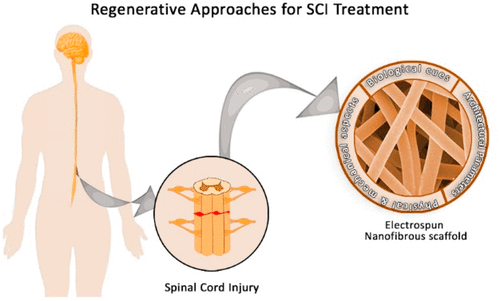当前位置:
X-MOL 学术
›
ACS Biomater. Sci. Eng.
›
论文详情
Our official English website, www.x-mol.net, welcomes your
feedback! (Note: you will need to create a separate account there.)
Recent Advances in the Regenerative Approaches for Traumatic Spinal Cord Injury: Materials Perspective
ACS Biomaterials Science & Engineering ( IF 5.4 ) Pub Date : 2020-11-16 , DOI: 10.1021/acsbiomaterials.0c01074 Walaa A. Abbas 1 , Maha E. Ibrahim 2 , Manar El-Naggar 1 , Wessam A. Abass 3 , Ibrahim H. Abdullah 1 , Basem I. Awad 4 , Nageh K. Allam 1
ACS Biomaterials Science & Engineering ( IF 5.4 ) Pub Date : 2020-11-16 , DOI: 10.1021/acsbiomaterials.0c01074 Walaa A. Abbas 1 , Maha E. Ibrahim 2 , Manar El-Naggar 1 , Wessam A. Abass 3 , Ibrahim H. Abdullah 1 , Basem I. Awad 4 , Nageh K. Allam 1
Affiliation

|
Spinal cord injury (SCI) is a devastating health condition that may lead to permanent disabilities and death. Understanding the pathophysiological perspectives of traumatic SCI is essential to define mechanisms that can help in designing recovery strategies. Since central nervous system tissues are notorious for their deficient ability to heal, efforts have been made to identify solutions to aid in restoration of the spinal cord tissues and thus its function. The two main approaches proposed to address this issue are neuroprotection and neuro-regeneration. Neuroprotection involves administering drugs to restore the injured microenvironment to normal after SCI. As for the neuro-regeneration approach, it focuses on axonal sprouting for functional recovery of the injured neural tissues and damaged axons. Despite the progress made in the field, neural regeneration treatment after SCI is still unsatisfactory owing to the disorganized way of axonal growth and extension. Nanomedicine and tissue engineering are considered promising therapeutic approaches that enhance axonal growth and directionality through implanting or injecting of the biomaterial scaffolds. One of these recent approaches is nanofibrous scaffolds that are used to provide physical support to maintain directional axonal growth in the lesion site. Furthermore, these preferable tissue-engineered substrates can afford axonal regeneration by mimicking the extracellular matrix of the neural tissues in terms of biological, chemical, and architectural characteristics. In this review, we discuss the regenerative approach using nanofibrous scaffolds with a focus on their fabrication methods and their properties that define their functionality performed to heal the neural tissue efficiently.
中文翻译:

创伤性脊髓损伤再生方法的最新进展:材料角度
脊髓损伤(SCI)是一种破坏性健康状况,可能导致永久性残疾和死亡。了解创伤性SCI的病理生理学观点对于定义有助于设计恢复策略的机制至关重要。由于中枢神经系统组织因其缺乏康复能力而臭名昭著,因此人们努力寻找解决方案以帮助脊髓组织及其功能的恢复。为解决该问题而提出的两种主要方法是神经保护和神经再生。神经保护涉及在SCI后给予药物以使受伤的微环境恢复正常。至于神经再生方法,它着重于轴突发芽,以恢复受损神经组织和受损轴突的功能。尽管该领域取得了进展,由于轴突生长和伸展的方式混乱,SCI后的神经再生治疗仍然不能令人满意。纳米医学和组织工程学被认为是有前途的治疗方法,可以通过植入或注射生物材料支架来增强轴突的生长和方向性。这些最近的方法之一是纳米纤维支架,其用于提供物理支持以维持病变部位的定向轴突生长。此外,就生物学,化学和建筑特性而言,这些优选的组织工程化基质可通过模仿神经组织的细胞外基质来提供轴突再生。在这篇评论中
更新日期:2020-12-14
中文翻译:

创伤性脊髓损伤再生方法的最新进展:材料角度
脊髓损伤(SCI)是一种破坏性健康状况,可能导致永久性残疾和死亡。了解创伤性SCI的病理生理学观点对于定义有助于设计恢复策略的机制至关重要。由于中枢神经系统组织因其缺乏康复能力而臭名昭著,因此人们努力寻找解决方案以帮助脊髓组织及其功能的恢复。为解决该问题而提出的两种主要方法是神经保护和神经再生。神经保护涉及在SCI后给予药物以使受伤的微环境恢复正常。至于神经再生方法,它着重于轴突发芽,以恢复受损神经组织和受损轴突的功能。尽管该领域取得了进展,由于轴突生长和伸展的方式混乱,SCI后的神经再生治疗仍然不能令人满意。纳米医学和组织工程学被认为是有前途的治疗方法,可以通过植入或注射生物材料支架来增强轴突的生长和方向性。这些最近的方法之一是纳米纤维支架,其用于提供物理支持以维持病变部位的定向轴突生长。此外,就生物学,化学和建筑特性而言,这些优选的组织工程化基质可通过模仿神经组织的细胞外基质来提供轴突再生。在这篇评论中











































 京公网安备 11010802027423号
京公网安备 11010802027423号